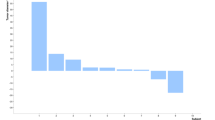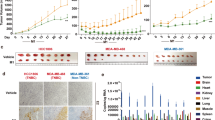Abstract
Adenovirus-p53-mediated apoptosis has been extensively evaluated in animal xenografts derived from human epithelial tumors and recently began testing in phase I clinical trials, but has not been evaluated for lymphoid malignancies. Cell lines derived from anaplastic large cell lymphoma (ALCL) carrying the t(2;5) translocation are efficiently transduced by adenoviral vector expressing p53 and undergo apoptosis. To test the in vivo efficiency of adenovirus-mediated-p53 expression and apoptosis induction, SUDHL-1 cells (derived from human ALCL) were injected subcutaneously into athymic nude mice. Cells from the xenograft had typical morphology of human ALCL by standard hematoxylin-eosin staining, CD5+, CD45+ and CD30+ immunophenotype, the t(2;5) translocation by PCR. Six tumors from an initial set of mice were evaluated for apoptosis by TUNEL and for necrosis by hematoxylin-eosin staining 48–72 h after injection with 1 × 108 p.f.u. of AdWTp53 (adenoviral vector expressing p53), of AdNull (adenoviral vector backbone) and PBS (mock), respectively. TUNEL staining was positive only in tumors injected with AdWTp53 and was mainly localized around the needle track. Differences of the means of the counts of the necrotic cells were statistically significant at P = 0.02 between AdWTp53 and mock and only borderline between AdWTp53 and AdNull. Twenty-three tumors from a separate set of mice were subsequently injected with AdWTp53, AdNull and PBS and evaluated for in vivo tumor response. Three total injections of viral vectors (1 × 108 p.f.u.) and PBS were given every 48–72 h. Only tumors injected with AdWTp53 showed tumor growth inhibition with a mean final tumor volume that was statistically significantly smaller than AdNull (P = 0.007) and mock (P = 0.002). Based on these results we foresee a potential application of adenovirus-mediated p53 apoptosis as gene therapy of lymphomas.
This is a preview of subscription content, access via your institution
Access options
Subscribe to this journal
Receive 12 print issues and online access
$259.00 per year
only $21.58 per issue
Buy this article
- Purchase on Springer Link
- Instant access to full article PDF
Prices may be subject to local taxes which are calculated during checkout




Similar content being viewed by others
References
Nielsen LL, Maneval DC . p53 tumor suppressor gene therapy for cancer Cancer Gene Ther 1998 5: 52–63
O'Malley BW Jr, Chen SH, Schwartz MR, Woo SL . Adenovirus-mediated gene therapy for human head and neck squamous cell cancer in a nude mouse model Cancer Res 1995 55: 1080–1085
Asgari K et al. Inhibition of the growth of pre-established subcutaneous tumor nodules of human prostate cancer cells by single injection of the recombinant adenovirus p53 expression vector Int J Cancer 1997 71: 377–382
Li Z et al. Efficacy of multiple administrations of a recombinant adenovirus expressing wild-type p53 in an immune-competent mouse tumor model Gene Therapy 1998 5: 605–613
Clayman GL et al. Adenovirus-mediated p53 gene transfer in patients with advanced recurrent head and neck squamous cell carcinoma J Clin Oncol 1998 16: 2221–2232
Schuler M et al. A phase I study of adenovirus-mediated wild-type p53 gene transfer in patients with advanced non-small cell lung cancer Hum Gene Ther 1998 9: 2075–2082
Herman JR et al. In situ gene therapy for adenocarcinoma of the prostate: a phase I clinical trial Hum Gene Ther 1999 10: 1239–1249
Meeker TC et al. Adenoviral vectors efficiently target cell lines derived from selected lymphocytic malignancies including anaplastic large cell lymphoma and Hodgkin's disease Clin Cancer Res 1997 3: 357–364
Turturro F, Seth P, Link CJ Jr . In vitro adenoviral vector p53-mediated transduction and killing correlates with expression of coxsackie-adenovirus receptor and αvβ5 integrin in SUDHL-1 cells derived from anaplastic large cell lymphoma Clin Cancer Res 2000 6: 185–192
Pasqualucci L et al. Antitumor activity of anti-CD30 immunotoxin (Ber-H2/saporin) in vitro and in severe combined immunodeficiency disease mice xenografted with human CD30+ anaplastic large-cell lymphoma Blood 1995 85: 2139–2146
Beylot-Barry M et al. Characterization of t(2;5) reciprocal transcripts and genomic breakpoints in CD30+ cutaneous lymphoproliferations Blood 1998 91: 4668–4676
Tilly H et al. Primary anaplastic large-cell lymphoma in adults: clinical presentation, immunophenotype, and outcome Blood 1997 90: 3727–3734
Morgan R et al. Lack of involvement of the c-fms and N-myc genes by chromosomal translocation t(2;5)(p23;q35) common to malignancies with features of so-called malignant histiocytosis Blood 1989 73: 2155–2164
Stewart AK et al. In vivo adenoviral-mediated gene transfer of interleukin-2 in cutaneous plasmocytoma Blood 1998 91: 1095–1097
Teoh G et al. Adenovirus vector-based purging of multiple myeloma cells Blood 1998 92: 4591–4601
Morris SW et al. Fusion of a kinase gene, ALK to a nuclear protein gene, NPM in non-Hodgkin's lymphoma Science 1994 263: 1281–1284
Katayose D et al. Cytotoxic effects of adenovirus-mediated wild-type p53 protein expression in normal and tumor mammary epithelial cells Clin Cancer Res 1995 1: 889–897
Acknowledgements
This work was supported by a generous grant from Des Moines Research and Education VA Central Iowa Health Care System, Des Moines, IA. We thank Dr S Morris, St Jude Children's Research Hospital and Dr S Smith, University of Kansas, who kindly provided SUDHL-1 and SUPM2 cell lines. We are grateful to T Radosevich and A Frist for help with figure preparation and Jane Spencer for editorial assistance.
Author information
Authors and Affiliations
Rights and permissions
About this article
Cite this article
Turturro, F., Heineke, H., Drevyanko, T. et al. Adenovirus-p53-mediated gene therapy of anaplastic large cell lymphoma with t(2;5) in a nude mouse model. Gene Ther 7, 930–933 (2000). https://doi.org/10.1038/sj.gt.3301186
Received:
Accepted:
Published:
Issue Date:
DOI: https://doi.org/10.1038/sj.gt.3301186



